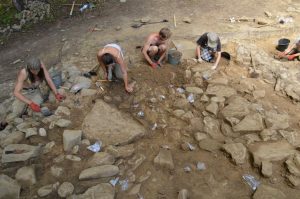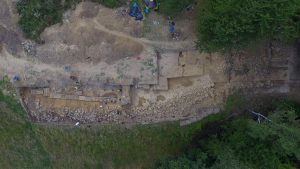Researchers have unearthed the gate leading to the fortified settlement at Zyndram’s Hill in Maszkowice. The site, dating back to the 2nd millennium BC is considered the oldest site with monumental stone fortifications in the area of Poland, discovered so far.

The settlement is being excavated for seven years now. First artefacts dating back to the Bronze Age were discovered at the site during initial research during the 1960s and ’70s. On the course of the recent excavations, archaeologists led by Marcin S. Przybyła unearthed stone walls surrounding the hilltop and a ramp leading to the point at the northern side of the settlement. It is believed that the entrance to the fortification was located there, as archaeologists unearthed a gate-like structure with adjacent fortifications flanking it from both sides, as a sort of bastions. These structures are poorly preserved, but clear in their outline, as the researchers state.

The settlement has been created around 1750 BC and was a planned and organised effort. Similar fortifications from the region of Central Europe are not known, but structures that are somewhat alike have been found in France, Italy and Croatia. But the uniqueness of this site is emphasized by the fact, that first monumental stone structures of this size in the area of Poland were built as late as 14th century AD – until then fortifications were mainly made of wood and earth. Researchers believe that the settlement ended in a sudden event around 1550-1500 BC. So far they haven’t found traces of raid, destruction, or a catastrophic event. They have found traces of a large fire that broke out in the middle of the period of settlement, but the houses that burnt have been rebuilt – there were fewer of them but they were also larger. The reasons for abandoning the site remain so far a mystery.

The settlement at Maszkowice covered an area of half of a hectare. A number of around 20 houses were located there, inhabited by 150-200 individuals. The locals thrived breeding cattle, growing wheat, gathering wild forest fruit, and hunting wild animals. Among the remains found at the site, archaeologists identified the bones of wolves, wild birds, and even of a brown bear. Other finds include bronze and iron artefacts and numerous pottery fragments, some of which link the site with the Mycenaean civilisation of the Bronze Age, and the domains of cultures thriving in the region of the Adriatic Sea and middle course of Danube river.

(after Marcin S. Przybyła, Nauka w Polsce, Gazeta Krakowska & Damian Radziak)